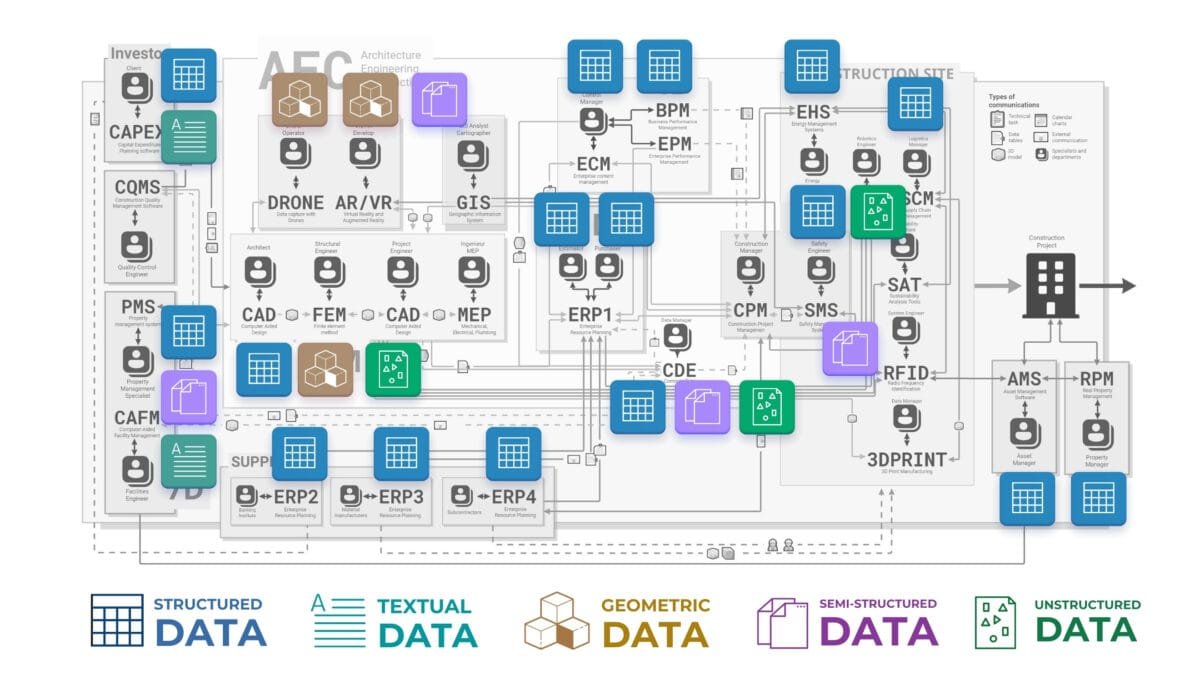In the context of companies in the construction industry, we are faced daily with a vast palette of different business cases and data management systems that need to be populated with multiformat information.
Whether it is large corporations or medium-sized companies, hundreds of highly qualified specialists are engaged every day in filling hundreds of software systems with various interfaces with information, which, with the help of managers, must interact with each other in a coherent manner. It is this complex of interacting systems and processes that ultimately brings profit to the company.
Each of the categories of systems we have discussed earlier and used in the construction industry load and process different types of data specific to their functions. To our existing list of systems and data types, we will add format types and documents:
- Investor (CAPEX)
- Financial data: budgets, expenditure forecasts (Structured data).
- Market trend data: market analysis (Structured and Unstructured data).
- Legal and contractual data: contracts (Text data).
- Management systems (PMS, CAFM, CQMS)
- Project data: graphs, tasks (structured data).
- Facility maintenance data: maintenance plans (text and structured data).
- Quality control data: standards, inspection reports (textual and unstructured data).
- CAD and BIM
- Technical drawings: architectural, structural plans (geometric data, unstructured data).
- Building models: 3D models, material data (geometric and Semi-structured data).
- Engineering calculations: load analysis (structured data).
- Construction site management systems (EHS, SCM)
- Safety and health data: safety protocols (textual and structured data).
- Supply chain data: inventory, orders (structured data).
- Daily reports: working hours, productivity (structured data).
- Drones, AR/VR, GIS, 3D printing
- Geodata: topographic maps (geometric and structured data).
- Real-time data: video and photos (unstructured data).
- Models for 3D printing: digital drawings (geometric data).
- Additional Management Systems (4D BPM, 5D ERP1, 8D CPM)
- Time and cost data: schedules, estimates (structured data).
- Change management: records of project modifications (text and structured data).
- Performance reporting: measures of success (structured data).
- Data Integration and Communication (CDE, RFID, AMS, RPM)
- Exchange data: document exchange, data models (structured and textual data).
- RFID and tracking data: logistics, asset management (structured data).
- Monitoring and control: sensors at sites (structured and unstructured data).

The construction industry uses a variety of systems that handle structured, textual, geometric, and unstructured data
Structured data is characterized by ease of retrieval and analysis, while processing of semi-structured and unstructured data requires more advanced tools and techniques for efficient retrieval and additional effort to understand and interpret it.
The bottom line is that date engineers in any company are faced with a salad of differently formatted documents, where each type of data needs its own special approach.

















